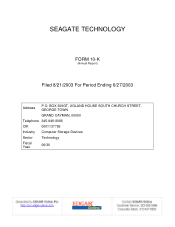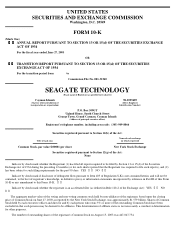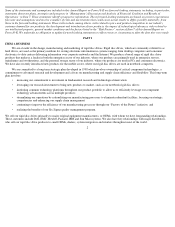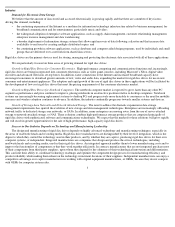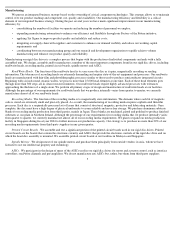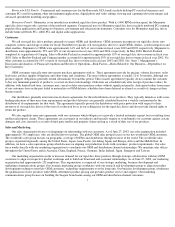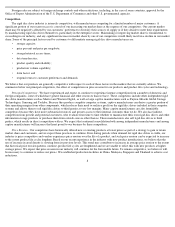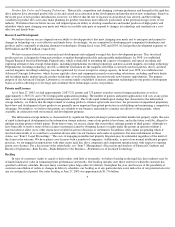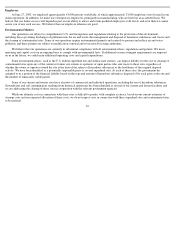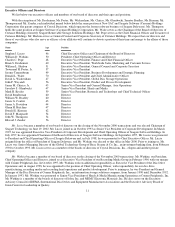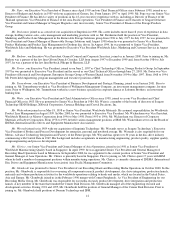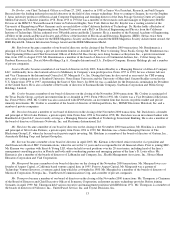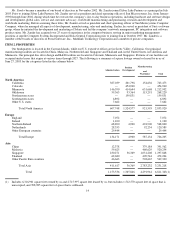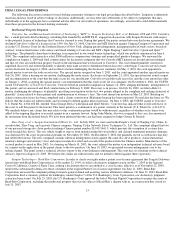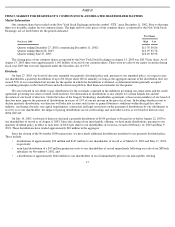Seagate 2002 Annual Report Download - page 10
Download and view the complete annual report
Please find page 10 of the 2002 Seagate annual report below. You can navigate through the pages in the report by either clicking on the pages listed below, or by using the keyword search tool below to find specific information within the annual report.
Barracuda ATA Family . Commercial and consumer uses for the Barracuda ATA family include desktop PCs used in businesses and
consumer PCs used for gaming, other entertainment applications, digital photo and video editing, viewing and capturing television images and
advanced spreadsheet modeling and graphics.
Momentus Family. Momentus is our introductory notebook rigid disc drive product. With its 5400 RPM rotation speed, the Momentus
rigid disc drives target only a portion of the notebook segment. Commercial uses for Momentus rigid disc drives include notebook PCs running
popular office applications and laptops for business, government and education environments. Consumer uses for Momentus rigid disc drives
include home notebook PCs, tablet PCs and digital audio applications.
Customers
We sell our rigid disc drive products primarily to major OEMs and distributors. OEM customers incorporate our rigid disc drives into
computer systems and storage systems for resale. Distributors typically sell our rigid disc drives to small OEMs, dealers, system integrators and
other resellers. Shipments to OEMs were approximately 61% and 66% of our revenue in fiscal years 2003 and 2002, respectively. Shipments to
distributors were approximately 39% and 34% of our revenue in fiscal years 2003 and 2002, respectively. In May 2002, Hewlett-Packard
completed its acquisition of Compaq. Sales to Hewlett-Packard accounted for approximately 18% of our rigid disc drive revenue in fiscal year
2003. Sales to Hewlett-Packard and Compaq together accounted for approximately 20% of our rigid disc drive revenue in fiscal year 2002. No
other customer accounted for 10% or more of our rigid disc drive revenue in fiscal years 2003 and 2002. See “Item 7. Management’s
Discussion and Analysis of Financial Condition and Results of Operations—Risk Factors—Risks Related to Our Business—Dependence on
Key Customers.”
OEM customers typically enter into master purchase agreements with us. These agreements provide for pricing, volume discounts, order
lead times, product support obligations and other terms and conditions. The term of these agreements is usually 12 to 36 months, although our
product support obligations generally extend substantially beyond this period. These master agreements typically do not commit the customer
to buy any minimum quantity of products, or create exclusive relationships. Deliveries are scheduled only after receipt of purchase orders. In
addition, with limited lead time, customers may cancel or defer most purchase orders without significant penalty. Anticipated orders from many
of our customers have in the past failed to materialize or OEM delivery schedules have been deferred or altered as a result of changes in their
business needs.
Our distributors generally enter into non-exclusive agreements for the redistribution of our products. They typically furnish us with a non-
binding indication of their near-term requirements and product deliveries are generally scheduled based on a weekly confirmation by the
distributor of its requirements for that week. The agreements typically provide the distributors with price protection with respect to their
inventory of our rigid disc drives at the time of a reduction by us in our selling price for the rigid disc drives and also provide limited rights to
return the product.
We also regularly enter into agreements with our customers which obligate us to provide a limited indemnity against losses resulting from
intellectual property claims. These agreements are customary in our industry and typically require us to indemnify our customer against certain
damages and costs incurred as a result of third party intellectual property claims arising as a result of their use of our products.
Sales and Marketing
Our sales organization focuses on deepening our relationship with our customers. As of June 27, 2003, our sales organization included
approximately 391 employees, who are divided into two groups. The global OEM sales group focuses on our key worldwide OEM customers.
The worldwide sales group focuses on geographic coverage of OEMs and distributors throughout most of the world. The worldwide sales
group is organized regionally among the United States, Japan, Asia-Pacific (excluding Japan) and Europe, Africa and the Middle East. In
addition, we have a sales operations group which focuses on aligning our production levels with customers’ product requirements. Our sales
force works directly with our marketing organization to coordinate our OEM and distribution channel relationships. We maintain sales offices
throughout the United States and in Australia, China, England, France, Germany, India, Ireland, Japan, Singapore and Taiwan.
Our marketing organization works to increase demand for our rigid disc drive products through strategic collaboration with key OEM
customers to align our respective product roadmaps and to build our brand and end-customer relationships. As of June 27, 2003, our marketing
organization had approximately 252 employees. This organization is comprised of our strategic marketing, business development and
marketing communications groups. Our strategic marketing group coordinates with our research and development group to align our product
development roadmap to meet key OEM customers’ technology requirements over the long term. Our business development group coordinates
the qualification of new products with OEMs, determines product pricing and provides product service and support. Our marketing
communications group focuses on building the Seagate brand name among our OEM and distribution channel customers.
7

